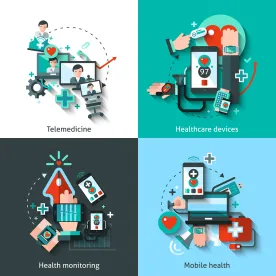On April 26, Commissioner Gottlieb addressed the agency’s progress on FDA’s Digital Health Innovation Action Plan and announced several additional steps the agency is taking to advance the potential benefits of digital health. Here is a recap of the key updates:
(1) Launch of New FDA Program to Apply Digital Health to Drugs
As our readers are aware, FDA has provided little public insight to date around the Agency’s regulatory approach to digital health associated with pharmaceuticals. Commissioner Gottlieb recognized the regulatory uncertainty and announced that FDA will seek public input “on the right approach to incorporating software that’s designed to be used with prescription drugs” and “expand the opportunities to use digital health tools as part of drug development.” Specifically, FDA intends to:
-
Request input on how FDA can support development of digital health tools for approved drugs, including how to properly regulate software that undergoes rapid cycles of innovation;
-
Establish clear policies around how digital health tools can be baked into drug development programs;
-
Clarify that not all FDA requirements apply every time a digital health tool is employed in relation to a prescription drug or by a pharmaceutical manufacturer;
-
Enable sponsors to comply with regulatory requirements using digital health tools, such as post-market surveillance requirements; and
-
Allow for new safety and efficacy claims to be supported by data collected through digital health solutions (e.g. increased activity, improved mood, or greater social interactions for patients treated for severe depression).
FDA has not yet opened the public docket, but stakeholders should consider providing input to FDA given the significance of the regulatory issues involved. The Commissioner noted that FDA intends to advance a new framework through guidance, presumably after seeking input through the public docket.
(2) Expansion and Public Input on the Pre-Certification Pilot Program
FDA took another step in developing the novel model for pre-market review of software devices and released a draft working model for the Pre-Certification program. The model describes four components: (1) excellence appraisal and precertification; (2) review pathway determination; (3) streamlined premarket review; and (4) real world performance. Under the model, developers of software as a medical device (SaMD) would be certified into one of two levels based on objective demonstration of commitment to five excellence principles and the developer’s prior experience delivering SaMD or medical devices. Whether a particular SaMD product by that developer requires premarket review would depend on the precertification level, the seriousness of the healthcare situation or condition addressed by the product, and the significance of the information provided by the product to a healthcare decision.
The working model includes a number of “challenge questions” on which the agency seeks input from stakeholders. The agency has stressed that the Pre-Cert program is intended to be an iterative, collaborative experience and is actively seeking stakeholder comments. FDA requested comments on the challenge questions for the working model by May 31, 2018. Comments may be submitted to the public docket electronically.
The agency also published a roadmap for next steps in the development of the program, under which the agency will launch “Pre Cert 1.0,” a first version of the program by the end of 2018, with further refinement of the program in 2019. There’s also been congressional interest in the program, which we’ll also continue to monitor for our clients.
On May 10, 2018, FDA will host an interactive user session to discuss the agency’s progress on the Pre-Cert pilot program, the working model, and the roadmap.
(3) New Framework for FDA’s Approach to Artificial Intelligence
Given the rapidly expanding use of AI-based technologies in health care, Commissioner Gottlieb announced that FDA was “actively developing a new regulatory framework to promote innovation . . . and support the use of AI-based technologies.” This includes applying the Pre-Cert program in a way that accounts for the ability of machine learning-based technologies to improve over time, by allowing pre-certified companies to make certain minor changes without premarket review. In addition, the agency will ensure that other aspects of the regulatory framework, “such as new software validation tools, are sufficiently flexible to keep pace with the unique attributes of this rapidly advancing field.”
FDA expects an increasing number of AI-based premarket submissions. The agency is working with AI experts to understand how AI-based technologies can be validated and “and how patients and providers can be confident that they’re reliable, unbiased, and will help improve health outcomes.” In addition, FDA will consider how to communicate to patients and providers the connection between decision-making in traditional health care settings and the use of these advanced technologies.
(4) Continued FDA Guidance Implementing the Cures Act: Multiple Functions Guidance
Pursuant to the agency’s Digital Health Innovation Action Plan, FDA issued a draft guidance, “Multiple Function Device Products: Policy Considerations,” addressing products that contain multiple functions, some of which are subject to FDA regulatory oversight as medical devices and others of which are not. The Center for Devices and Radiological Health (CDRH) and the Center for Biologics Evaluation and Research (CBER) issued the draft guidance, but the Center for Drug Evaluation and Research (CDER) did not join. The 21st Century Cures Act outlined a function-by-function approach to determining appropriate FDA regulation of health and medical software, and the Cures Act permits FDA to regulate only those software functions that meet the definition of a device, although the agency may consider the impact of the non-device software functions on the regulated device functions. While the Cures Act provision is specific to software, the new draft guidance applies to other types of products that include both device and non-device functions.
Stakeholders can submit comments on the draft guidance in the electronic docket through June 26, 2018.
(5) New Digital Safety Reporting for Drug and Biologic Clinical Trials
FDA will implement a new program to enable a unified data standard for meeting electronic reporting requirements under the expedited safety-reporting regulations of an Investigational New Drug application (IND). According to FDA, the program builds off a recently-completed pilot program assessing the feasibility of a digital submission process in which IND safety reports were transmitted to FDA as data that can be easily visualized and analyzed. The goal of the new digital framework is to significantly improve the efficiency and accuracy of the premarket safety submission and review process.
(6) New Digital Health Incubator at FDA: INFORMED
The agency is creating an internal data science incubator called the Information Exchange and Data Transformation, or INFORMED. Launched in collaboration with HHS Innovation, Design, Entrepreneurship and Action (IDEA) Lab, the incubator will focus on the “conduct of regulatory science research in areas related to health technology and advanced analytics related to cancer” to help modernize the framework for “advancing promising digital health tools.”
INFORMED will:
-
Examine “modern approaches in evidence generation to support regulatory decisions,” with a special emphasis on oncology regulatory science;
-
Develop new clinical endpoints and signal detection methods for evaluation of the safety and effectiveness of therapies;
-
Develop new approaches for understanding variations in individual patient experience using diverse data sets from clinical trials, EHRs, and biometric monitoring devices; and
-
Develop principles and definitions for the validity and strength of AI -derived evidence in the context of product approval and regulations.




 />i
/>i

